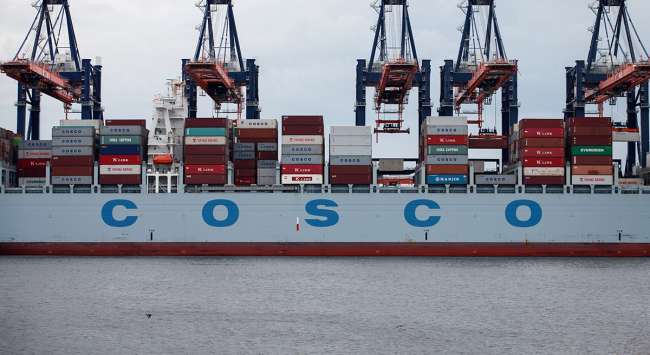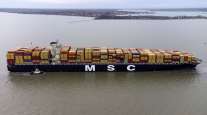Cosco Shipping Reaches Preliminary $6 Billion Deal With OOCL; Effect on Trucking Unclear

West Coast seaport officials and trucking executives are closely watching Cosco Shipping’s proposed $6.3 billion deal to purchase Orient Overseas International Ltd. to see how the consolidation would affect their businesses.
The pending acquisition, requiring approval from Cosco shareholders and regulators in China, would catapult Cosco ahead of CMA CGM as the world’s third-largest container carrier, behind the A.P. Moller–Maersk Group and Mediterranean Shipping Co., respectively. Cosco also would move from No. 12 on the Transport Topics Top 50 list of top global freight carriers into the top 10. The combined company’s Asia-North America service would surpass Maersk and CMA CGM and become No. 1 in volume, according to mariner data from Alphaliner.
Orient Overseas International subsidiary Orient Overseas Container Line operates the Middle Harbor terminal. Eventually, the ocean freight carrier will combine terminals at Pier E and Pier F into a single automated complex in Long Beach, Calif., according to ports and shipping lines.
Cosco and OOCL are two of the top four shipping lines that serve the Port of Long Beach.
The Harbor Trucking Association reports that Middle Harbor has consistently been the second-quickest terminal in Long Beach since March 2016. Matson’s terminal is slightly faster, on average, but also handles significantly lower container volumes than Middle Harbor and other facilities in San Pedro Bay.
Last month, the average turn time at Middle Harbor was 47 minutes, the fourth time in 2017 that the average was less than one hour.
HTA uses GPS technology and geofencing to measure the time from when a truck enters the queue to the entrance until it crosses the exit gate.
“The Cosco deal would be a good thing because OOCL already has the terminal of the future with Middle Harbor, and my guess is that they will move more cargo through Middle Harbor, which helps truckers worried about congestion. Middle Harbor is set up to handle the largest ships out there and it’s in the best position to go to 24-hour operations in the future,” association Executive Director Weston LaBar said.
Nevertheless, there are potential drawbacks to truck drivers serving the ports.
Tioga Group consultant Daniel Smith points out that draymen under exclusive contract with OOCL could lose their jobs or experience a significant cut in business from the transaction. Steamship lines offer store-door delivery to shippers, offering lower rates to handle the entire supply chain internally, including the truck trip.
“While it may simplify your life because it’s one less company to bargain with, one less set of chassis rules to deal with, but I may be worried if I have a nice relationship with OOCL because now that may disappear and I’ll have to compete with embedded Cosco-preferred carriers for a relationship,” Smith said.
However, Daniel Hackett of Hackett Associates believes that any changes from the consolidation would be gradual. Cosco executives already indicated that the two carriers will “continue to operate under their separate brands” even after the deal is completed, so Hackett believes there won’t be much of an operational effect on truckers or terminals for at least two years.
“I think this Cosco deal will be less of a seismic shift than the new alliances that began on April 1 [2017],” he said.




